.jpg)
Porsche 911 Turbo - MY 2000
Loosely translated from the original German
.jpg)
After a two-year break, Porsche presented a 911 Turbo again this year - even more powerful, even faster and even more ideal for long distances than its predecessor.
The new tailor-made suit for the fastest Porsche sports car fits perfectly. The rear fenders widen the rear by 65 millimeters compared to the 911 Carrera. This creates space for the standard 18-inch light alloy wheels with hollow spoke technology, on which tires in the dimensions 295/30 R 18 are mounted. This also creates the necessary space for the air inlets for the charge air cooling, which are cut very harmoniously into the rear side panels. In the rear area, a completely newly developed extendable wing and a newly designed rear panel with outlet openings for the charge air underline the incredibly powerful, but at the same time elegant appearance of the new Porsche top model. The front panel is only vaguely reminiscent of the 911 Carrera. Three large dark-clad openings signal the thirst for cool air. In order to meet the aerodynamic and thermodynamic requirements, extensive optimizations of the overall system have been carried out in parallel with the new design.
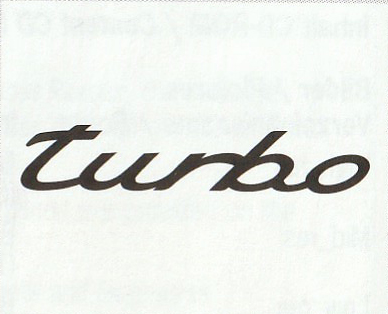
The sound in the rear is created by a 6-cylinder boxer engine with four valves each and a displacement of 3,600 cubic centimeters. With the support of the two exhaust turbochargers, it produces 309 kW (420 hp) at 6,000 rpm. Its maximum torque of 560 Nm is available at just 2,700 rpm and is available up to 4,600 rpm. As with the 911 Carrera engine, the cylinders and cylinder heads are flowed through with cooling water using the cross-flow principle from the hot to the cold side, which achieves an optimum homogeneous temperature distribution. The waste heat from the engine oil is absorbed by the cooling water via an oil/water heat exchanger. Due to the significantly higher engine power of the new 911 Turbo, the total surface area of the radiator had to be increased by more than 50 percent compared to the 911 naturally aspirated engine and the delivery capacity of the radiator fan and the radiator water pump had to be increased accordingly.
As with the previous model, the two chargers are arranged in parallel. The low intake manifold volume and short exhaust manifolds ensure good response. The intake air reaches the two compressors via a common air filter housing. From there, the compressed air is fed via a charge air cooler arranged in the wheel housings behind the rear wheels and brought together in front of the E-gas actuator. The recooling of the compressed charge air results in a high cylinder filling and low component temperatures. The so-called bypass valves are integrated in the turbine housings. The boost pressure is regulated by controlling the bypass valves with a common timing valve, which is controlled by the engine management system. The opening cross-section depends on the required boost pressure. At full load, it is around 1.80 bar, which is reached at around 2,700 rpm. As the speed continues to rise, the boost pressure is regulated. In the nominal power range, it is around 1.65 bar.
The gas exchange is controlled by a completely new system. Porsche calls it "VarioCam Plus". The system consists of four valves per cylinder, the axial camshaft adjusters and the switchable valve tappets. The two intake and exhaust valves are arranged in a V shape with a valve angle of 27.4 degrees. In order to keep the moving masses of the valve train as low as possible, the valve stem diameter is only six millimeters. In contrast to the 911 Carrera, double valve springs are used on the intake and exhaust valves to ensure that the valves close even when the forces caused by the exhaust back pressure are higher. The intake camshaft adjustment on the new 911 Turbo is expanded to include the intake valve lift switch. The valve lift adjustment system consists of two nested switchable bucket tappets on the intake side of the engine, which are operated by two different sized cams on the intake camshaft. This allows performance and torque to be optimized on the one hand and fuel consumption and exhaust emissions to be reduced on the other, as well as the improved running smoothness.
At 12.9 liters per 100 kilometers, the total consumption according to the EC standard is around 18 percent lower than the previous model. The high torque available at lower speeds supports a fuel-efficient driving style.
Thanks to VarioCam Plus and the new engine control unit with E-Gas, Porsche engineers have also made remarkable progress in reducing exhaust emissions. Compared to the previous model, they are on average around 50 percent lower in the European type approval process, meaning that the new 911 Turbo easily meets the very strict D4 exhaust emission limits are met, which are 1.0 g/km for CO, 0.1 g/km for HC and 0.08 g/km for NOx. This corresponds to the EU4 limits under standard test conditions, which will only become mandatory on January 1, 2005. Of course, the 911 Turbo also meets the very demanding LEV standard that applies in the USA.
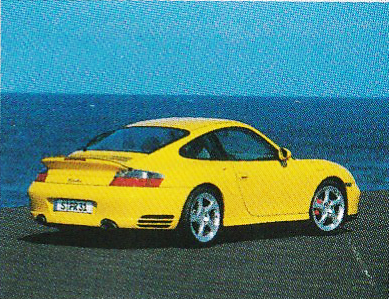
The performance of the new 911 Turbo is outstanding in the truest sense of the word and even surpasses the values of the 911 GT3. The Turbo with the standard six-speed manual transmission sprints from a standstill to 100 km/h in 4.2 seconds. It reaches the 160 km/h mark in 9.2 seconds. It only stops moving forward at a speed of 305 km/h. The impressive torque of 560 Nm already shows that the Turbo is also an exceptional vehicle when it comes to elasticity. It accelerates from 80 to 120 km/h in fifth gear in exactly five seconds.
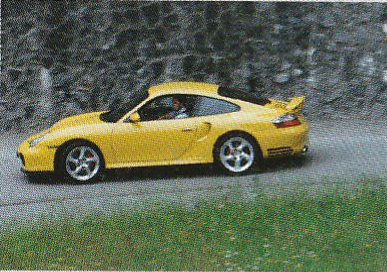
Like its predecessor, the new 911 Turbo is equipped with all-wheel drive as standard. Depending on the driving situation, the front wheels with 225/40 R 18 tires bring up to 40 percent of the drive power to the road. However, the focus is less on traction than on achieving outstanding driving characteristics and driving safety. The technology comes largely from the 911 Carrera 4, only the length of the cardan shaft had to be adjusted. The additional drive on the front axle is achieved via a viscoelastic coupling. This type of drive has the advantage, among other things, that there is no extreme pushing over the front wheels when cornering and neutral cornering and driving behavior is achieved.
Active driving safety is significantly supported by Porsche Stability Management (PSM), which is fitted as standard on the new 911 Turbo. The system uses sensors to detect whether the vehicle is following the path specified by the driver. If the vehicle swerves in extreme driving situations, it is stabilized again by targeted braking interventions on individual wheels. If this is not enough, PSM intervenes in the engine management to reduce the drive power. The combination of all-wheel drive, PSM and the sporty chassis tuning in conjunction with a lowering of ten millimeters guarantees a previously unattainable level of active safety.
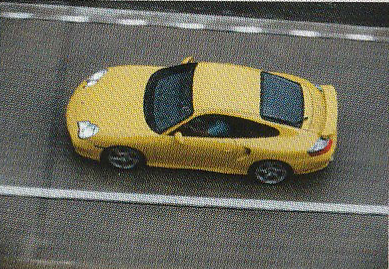
The new 911 Turbo also adopts the proven design principle of the brake system with monobloc fixed calipers in the Carrera. Due to the increased performance, however, larger and reinforced four-piston fixed calipers are responsible for deceleration on the front and rear axles. Of course, the perforated and internally ventilated brake discs are also larger. The diameter on the front axle is 330 millimeters and the width 34 millimeters. The rear axle has brake discs with the same diameter, only the width is reduced to 28 millimeters. This means that the pad surface on the front and rear axles is around five percent larger than on the previous model. These measures make extreme braking performance possible even under the toughest conditions, such as in motorsport.
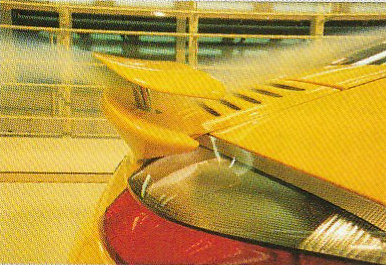
From late autumn 2000, Porsche will be offering the new 911 Turbo with an absolutely revolutionary brake system on request, which can also be retrofitted without any problem. Porsche is the first automobile manufacturer in the world to develop a ceramic composite brake disc with an involute cooling channel for efficient internal cooling. The new brake, called the "Porsche Ceramic Composite Brake" (PCCB), is a significant advance in the field of vehicle brake technology and sets completely new standards. This applies to such crucial criteria as responsiveness, fading stability, weight and service life.
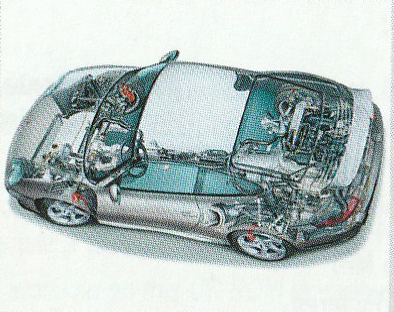
For the first time, Porsche is offering the 911 Turbo with Tiptronic S on request. With this five-speed automatic transmission, which can also be switched manually using rocker switches on the steering wheel, acceleration from 0 to 100 km/h is 4.9 seconds and the top speed is 298 km/h. The Tiptronic S in the 911 Turbo is a completely new development in order to cope with the considerable torque and power requirements of the turbo engine. To ensure that driving dynamics are not compromised, the transmission specialists have stored the well-known shifting strategies, which range from comfortable gliding to extremely sporty driving, in the electronic transmission control (EGS). With one small difference to before: the Turbo no longer has five shift programs stored in the EGS, but the shift points adapt continuously to the driving style and the route profile. Of course, the manual short-term influence in automatic mode is also part of the Tiptronic S's range of features in the Turbo.
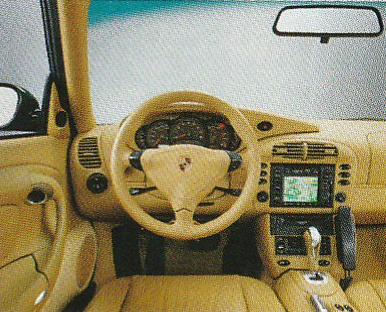
The new 911 Turbo comes with extensive and high-quality standard equipment. In addition to the equipment of the Carrera models, which are equipped with automatic air conditioning and a cassette radio as standard, the Turbo has a metallic paint finish, extensive leather upholstery, electrically adjustable seats with seat memory on the driver's side, a sound package and the three-spoke sports steering wheel with a colored Porsche crest. The 911 Turbo is also equipped with an on-board computer. The remote control for the ignition key can be used to open the trunk lid and operate the seat memory function.
Another equipment highlight are the new main headlights, which, in conjunction with the striking front apron and the widened fenders, give Porsche's top model a completely unique look. The so-called "Bi-Xenon" headlights, which are reserved exclusively for the 911 Turbo, project the light from the D2S xenon lamp onto the road through a large glass lens with a diameter of 70 millimeters. A movable cover enlarges the light emission area compared to the low beam, thus also realizing the wide-spread high beam as daytime-like xenon light. Like the Litronic system, the Bi-Xenon headlights offer automatic headlight range control and are combined with a headlight cleaning system.
.jpg)
.jpg)
.jpg)
.jpg)
.jpg)
Porsche 911 Turbo - MY 2000

Porsche 911 Turbo - MY 2002

Porsche Press kit

Porsche Literature

Our Porsche Cars